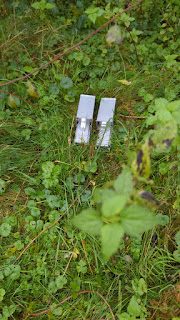The Elder Wand
One native tree present on the UEA campus is the elder (Sambucus nigra). They have pinnate leaves with 5-7 leaflets (left). But be careful examining the leaves - they have an unpleasant smell when bruised! The trunks (below) have grey-brown bark and often few branches. While I found this one in winter, later on in the year, they are characterised by cream flowers from late May, which develop into black berries after insect pollination by late summer and autumn. These flowers are, of course, elderflowers, and so are edible, often used in cordial. The elder berries are edible too! They are sometimes used in preserves, wines and baking. Be careful when foraging from elder though - the raw berries and other parts of the tree are poisonous. Not only humans enjoy to snack on elder, with the flowers and berries providing food for small mammals and birds, as well as nectar for pollinators. Furthermore they're also a foodplant for many caterpillars too!
There is a lot of mythology surrounding the elder, thanks to its association with the devil. Burning elder is thought to summon the devil, although confusingly planting it will ward the devil away. Maybe these superstitions come from its alternative name of the 'Judas tree', said to be the tree on which Judas hanged himself. The elder also carries more modern symbolism thanks to its role in the Harry Potter books. Perhaps its satanic symbolism inspired its use in the Elder Wand, one of the Deathly Hallows which could defeat any wand in a duel. In all seriousness though, elder wood is often used for whittling and carving, so maybe one could fashion a wand out of it after all! Stems can even be hollowed out for the all important core!





Comments
Post a Comment